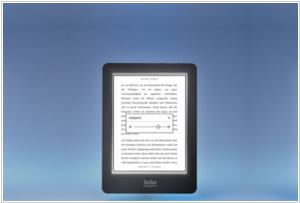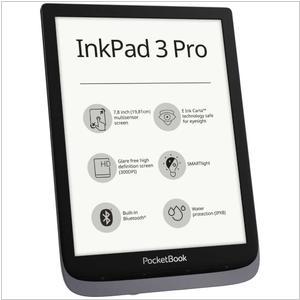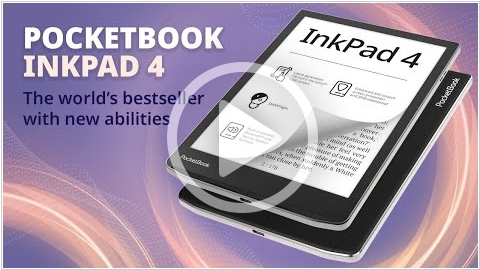Kobo Glo vs PocketBook InkPad
Last updated: July 09, 2023
Kobo Glo and PocketBook InkPad are two popular e-reader devices that offer distinct features and reading experiences, but they have notable differences in their design, display technology, and software.
Firstly, the Kobo Glo features a 6-inch E Ink Carta display, which provides a sharp and clear reading experience. It offers a front light that allows users to read in various lighting conditions without causing eye strain. The Glo provides a compact and lightweight design, making it highly portable for readers on the go. It includes a responsive touchscreen interface for easy navigation and page-turning. Kobo Glo supports a wide range of e-book formats and offers access to the Kobo bookstore, allowing users to purchase and download e-books directly on the device.
On the other hand, the PocketBook InkPad stands out with its larger 7.8-inch E Ink display, providing a more spacious reading area. The InkPad offers high resolution and excellent text clarity, ensuring a comfortable reading experience. It features front lighting with adjustable color temperature, allowing users to customize the lighting to their preferences. The InkPad also includes physical page-turn buttons for quick navigation and supports various e-book formats. It offers expandable storage options, enabling users to carry a vast library of books.
Another key difference lies in the software and features of the devices. The Kobo Glo runs on Kobo's proprietary firmware, providing a user-friendly interface and seamless integration with the Kobo ecosystem. It offers Wi-Fi connectivity, allowing users to access the Kobo bookstore, sync their reading progress across devices, and discover new titles. Kobo Glo supports features like customizable reading settings, in-book annotations, and access to the Kobo Plus subscription service. It provides a comprehensive reading experience within the Kobo ecosystem.
In comparison, the PocketBook InkPad operates on the PocketBook firmware, offering a highly customizable interface and access to various reading applications. It supports a wide range of e-book formats and provides access to online bookstores, allowing users to choose from multiple sources for e-book acquisition. The InkPad offers Wi-Fi connectivity, enabling users to browse the web, download apps, and access online bookstores directly from the device. It also supports expandable storage for a vast library and offers extensive customization options for font size, margins, and other reading settings.
Firstly, the Kobo Glo features a 6-inch E Ink Carta display, which provides a sharp and clear reading experience. It offers a front light that allows users to read in various lighting conditions without causing eye strain. The Glo provides a compact and lightweight design, making it highly portable for readers on the go. It includes a responsive touchscreen interface for easy navigation and page-turning. Kobo Glo supports a wide range of e-book formats and offers access to the Kobo bookstore, allowing users to purchase and download e-books directly on the device.
On the other hand, the PocketBook InkPad stands out with its larger 7.8-inch E Ink display, providing a more spacious reading area. The InkPad offers high resolution and excellent text clarity, ensuring a comfortable reading experience. It features front lighting with adjustable color temperature, allowing users to customize the lighting to their preferences. The InkPad also includes physical page-turn buttons for quick navigation and supports various e-book formats. It offers expandable storage options, enabling users to carry a vast library of books.
Another key difference lies in the software and features of the devices. The Kobo Glo runs on Kobo's proprietary firmware, providing a user-friendly interface and seamless integration with the Kobo ecosystem. It offers Wi-Fi connectivity, allowing users to access the Kobo bookstore, sync their reading progress across devices, and discover new titles. Kobo Glo supports features like customizable reading settings, in-book annotations, and access to the Kobo Plus subscription service. It provides a comprehensive reading experience within the Kobo ecosystem.
In comparison, the PocketBook InkPad operates on the PocketBook firmware, offering a highly customizable interface and access to various reading applications. It supports a wide range of e-book formats and provides access to online bookstores, allowing users to choose from multiple sources for e-book acquisition. The InkPad offers Wi-Fi connectivity, enabling users to browse the web, download apps, and access online bookstores directly from the device. It also supports expandable storage for a vast library and offers extensive customization options for font size, margins, and other reading settings.
12
Kobo Glo's revolutionary ComfortLight illuminates the screen with a soft, adjustable glow so you can read any eBook any time of day under the perfect light — no lamp required. Because Kobo Glo’s advanced high-res XGA Pearl E Ink screen doesn’t use a glass overlay for its front light technology, there’s never any glare, even in the brightest sunlight.
21
PocketBook InkPad - 8-inch premium E Ink e-reader with LED frontlight for the most comfortable reading day and night long. PocketBook InkPad 8 inches allows to see more information at a single page - you can easily make the font larger and turn pages frequently. PocketBook InkPad - the best choice for reading professional literature, periodicals, work with graphs and tables including PDF and Djvu. PocketBook InkPad is perfect for reading both at the workplace and at home. School and college students will appreciate e-reader of such a format, because the 8-inch screen is the closest to the standard size of most textbooks.
Kobo Glo vs PocketBook InkPad in our news:
2023. Pocketbook unveiled its first e-note - Pocketbook InkPad X Pro
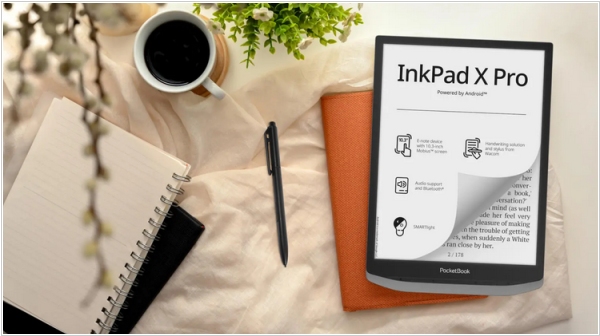
Pocketbook has introduced its first e-note, the Pocketbook InkPad X Pro, specifically crafted for digital note-taking. This innovative product is tailored for note-taking, freehand drawing, and PDF file editing due to its incorporation of a WACOM screen. The package includes a novel jet-black stylus with an eraser, boasting an impressive 4096 levels of pressure sensitivity. Nevertheless, the device is also compatible with third-party styluses. The highlight of the device is its 10.3-inch E INK Mobius display, which contributes to its lightweight design. Boasting a resolution of 1404×1872 pixels at 227 PPI, the screen is also capacitive, enabling users to employ finger gestures like pinch-to-zoom, tapping, and page-turning swipes. Convenient manual page-turn buttons, a home button, and settings button are situated at the device's bottom. Notably, this marks the company's first foray into the Android product realm, as all their previous offerings have been based on Linux. Anticipated to be released in late September, the InkPad X Pro will be priced at $420.00.
2023. Dark Mode is now available on new Pocketbook e-readers
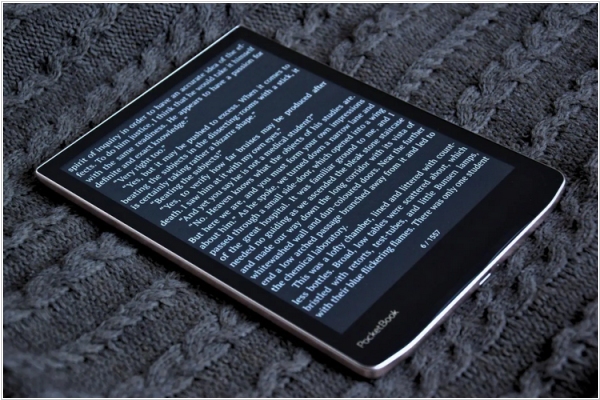
Dark mode is now an option on the Pocketbook Era, Pocketbook InkPad 4, and Pocketbook InkPad Color 2. This addition comes with the latest 6.8 firmware update that is accessible today. Along with dark mode, the update includes various other new features and improvements such as customizable control panel settings, additional filter options in the Notes app, a text suggestions feature, and more. In the near future, these enhancements will be made available for other Pocketbook models as well. Utilizing dark mode on your PocketBook device can enhance your reading experience in low-light conditions and during nighttime. This mode adjusts the display settings, showing white text on a dark background, which reduces contrast with the surrounding darkness and minimizes eye strain. Additionally, when reading in dark mode, you have the option to invert book illustrations if desired.
2023. Pocketbook Inkpad 4 gets 7.8-inch screen
Pocketbook announced the release of a new ereader called the Pocketbook Inkpad 4. It has a 7.8-inch E Ink Carta 1200 screen and a frontlight with temperature control. It has 32GB of storage space, built-in speakers for audiobooks and text-to-speech, and it’s waterproof with an IPX8 rating. Other specs for the PocketBook InkPad 4 include a USB-C port, a rotation sensor, a dual-core processor, it has WiFi and Bluetooth, and it has a 2000mAh battery. The overall design of the PocketBook InkPad 4 looks quite nice, though, with similar characteristics to the design of the PocketBook Era, which is actually really nice all except for the horribly washed-out screen. The newer E Ink Carta 1200 screens have better contrast, but it doesn’t matter when they add a cloudy flush front layer over the top of it.
2023. Pocketbook 6.7 firmware update adds audio pronunciation
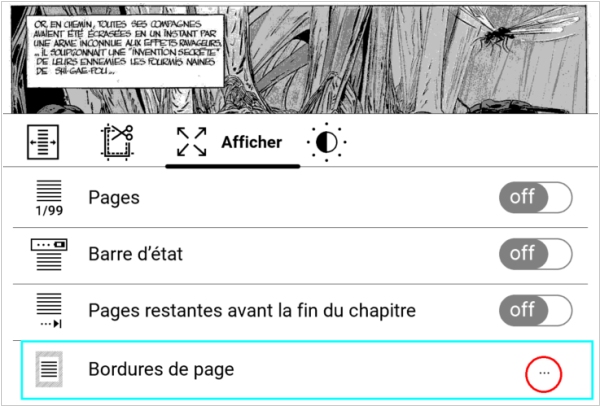
Pocketbook has recently launched a firmware update for the Inkpad 3, Inkpad Color, and Touch HD 3, bringing along a range of significant new features. Notably, users can now initiate audio pronunciation within the dictionary, enhancing the language learning experience. Additionally, translations can be saved directly to the device and exported for future reference. The update also introduces improved page borders for CBR, CBZ, and PDF documents, enhancing the visual presentation. Furthermore, the new firmware includes enhancements such as an expanded pressure area for more convenient navigation through footnotes in books, more precise page margins in scrollable PDF books, and improved algorithms for sorting the note list.
2021. New PocketBook InkPad Lite 970 has cheap 9.7-inch E Ink Screen
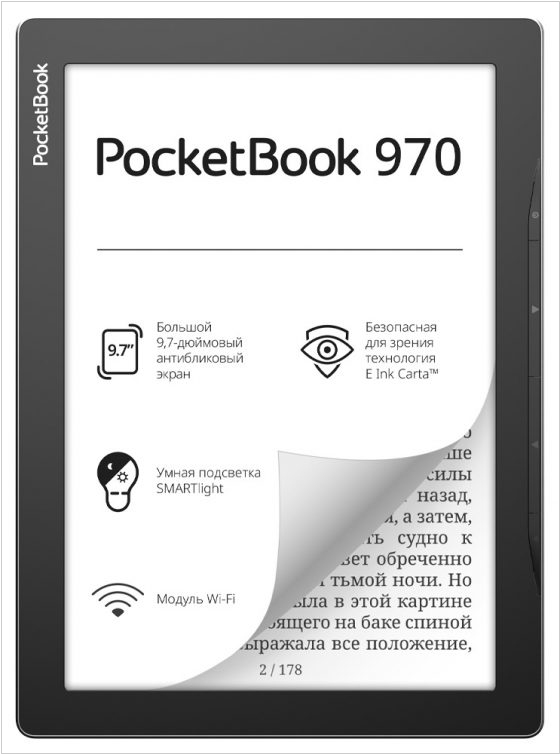
PocketBook has introduced the PocketBook InkPad Lite, a new budget ereader equipped with a 9.7-inch E Ink Carta screen. Set to be released in autumn 2021, the device is expected to be priced at $299, making it the most affordable large-screen ereader on the market by approximately $50. However, the PocketBook InkPad Lite is raising eyebrows due to its peculiar screen choice. PocketBook has opted for the cheapest screen available, featuring a resolution of 1200 x 825, which is the same resolution used by 9.7-inch E Ink screens over a decade ago. This results in a pixel density of only 150 ppi. In comparison, the Likebook P10 offers a superior screen with 200 ppi and is only slightly more expensive. Furthermore, the Likebook P10 boasts an upgraded quad-core CPU with 2GB of RAM and runs on a more versatile Android operating system.
2020. Pocketbook Inkpad 3 gets a brand new UI
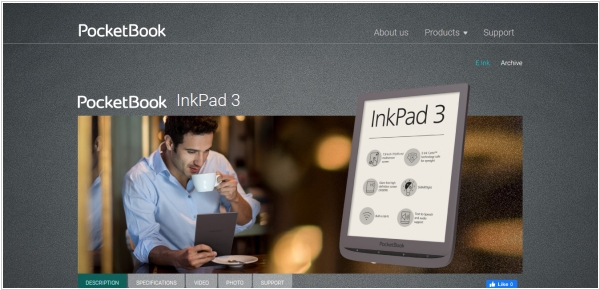
Pocketbook has recently released a significant update for its popular model, the InkPad 3. The update introduces an enhanced UI design across all applications, including redesigned notifications, control panel, and status bar. Firmware 6.1 brings a reimagined and simplified authorization system, enabling users to log into various services such as PocketBook Cloud, PocketBook Store, Send-to-PocketBook, and ReadRate using a single account. Additionally, users now have the convenience of logging into their personal accounts via the PocketBook app on their smartphones by scanning a QR code. The update also introduces support for new book formats, CBR and CBZ, allowing users to read comics on the device. Furthermore, the new Notes application enables users to view, edit, and add comments to their notes, as well as transfer them to other devices. All records are now consolidated in a single location, streamlining the search process.
2019. Kobo boosts performance of PDF files
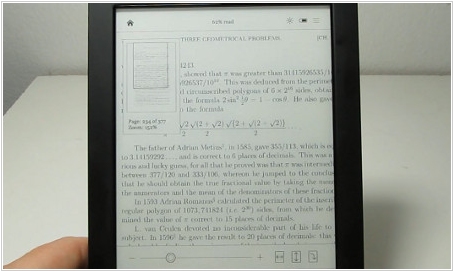
Kobo has recently rolled out a firmware update for their complete lineup of e-readers. This update enhances the performance of PDF files, leading to quicker loading times. Moreover, users now have the option to customize the header and footer of their reading interface. They can opt to showcase page numbers, percentage read, time remaining, or even deactivate the header, footer, or progress bar entirely.
2019. Kobo brings many of the Libra H2O features to older Kobo e-readers
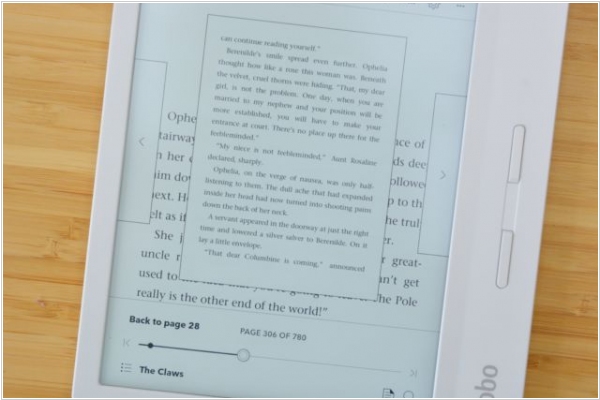
Kobo has released a new firmware update for the Kobo Touch, Kobo Glo, and Kobo Aura, incorporating several features found in the latest Kobo Libra H2O model to enhance eBook navigation. The headers and footers now provide information on both chapter and book progress, ensuring you can easily track your reading position. Additionally, a progress bar offers a visual representation of your progress within the book. For further customization, you can adjust your page layout through the Reading settings. The book scrubber has been improved, now displaying the entire book instead of just individual chapters, allowing for smoother navigation. Lastly, the addition of page previews enables quick referencing and facilitates navigation to different sections of the book.
2018. Pocketbook e-Readers get gesture controls
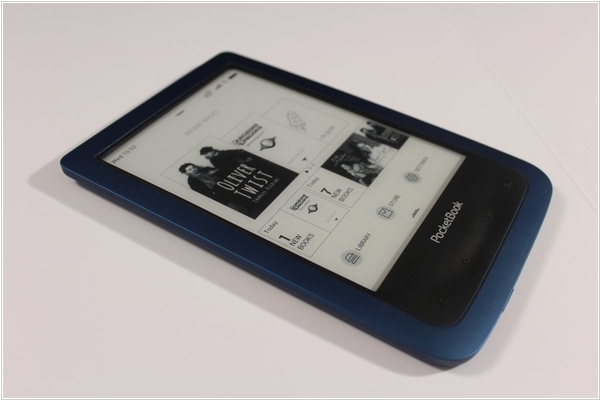
Pocketbook has introduced a fresh firmware update for its Aqua 2, InkPad 3, and Touch HD e-readers, incorporating gesture controls for adjusting the brightness and color temperature of the front-lit display. While reading an ebook, you can simply swipe your finger up or down the left side of the screen to increase or decrease the light intensity. This functionality works seamlessly in both portrait and landscape modes. The update also brings enhancements such as improved gesture-based page scaling for books in PDF or DjVu formats, enhanced accuracy when selecting words for note-taking purposes, and the ability to enable or disable the position sensor through the settings menu.
2017. Kobo makes managing ebooks simpler
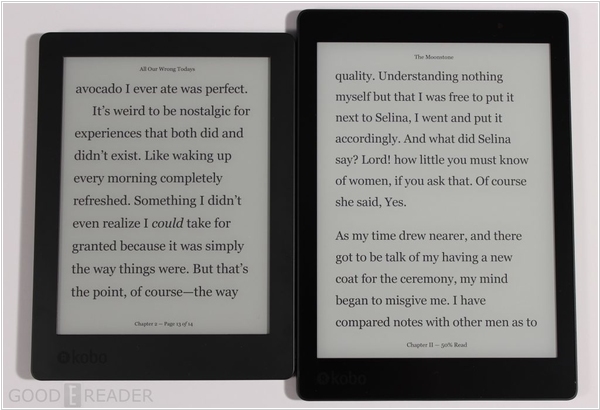
Kobo has recently released a firmware update for its e-readers, introducing several noteworthy features. One of the key additions is the "Manage Books" feature, accessible under the "My Books" section. This new feature allows users to select multiple books simultaneously, enabling actions such as marking them as finished or unread, removing them, or adding them to collections. The "My Books" section itself has undergone a visual enhancement, offering a cleaner layout of information, along with the inclusion of convenient Filter and Sort menus. The reading experience has also been enhanced with this update. Now, by tapping the middle of the page, users can easily access reading menus, navigate to the Table of Contents, or adjust Reading Settings. Additionally, the screen will now refresh after each chapter, as opposed to every six pages, providing a smoother reading experience.
2016. Pocketbook Announces the InkPad 2
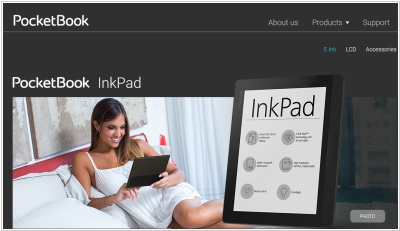
Pocketbook InkPad 2 is an exciting new e-reader that was just announced today. This innovative device boasts an 8-inch touchscreen display with an impressive resolution of 1,200 x 1,600 pixels. It features a front-lit display for optimal reading conditions and convenient physical page turn buttons. The InkPad 2 is powered by a 1 GHz processor and equipped with 512 MB RAM. While it offers 4 GB of internal memory, you have the flexibility to expand it up to 32 GB using a Micro SD card. One appealing feature of this e-reader is the inclusion of a 3.5mm headphone jack, allowing users to enjoy audiobooks and music. The Pocketbook InkPad 2 is expected to be available in the near future, priced at $199 Euros.
2015. Kobo unveiled new e-Reader Glo HD to take on Kindle Voyage
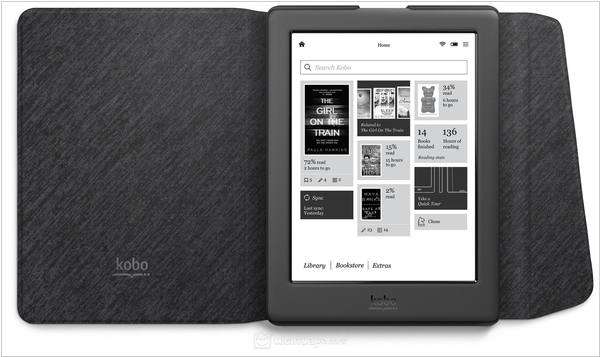
Kobo is set to release its latest e-reader, the Glo HD, which claims to offer the highest resolution at an affordable price point. Priced at $129.99 and launching on May 1, this new device from Rakuten-owned Kobo features a 6-inch display with an impressive 300 ppi pixel density. This resolution matches that of the $199.99 Kindle Voyage, ensuring extremely sharp and pixel-free text rendering. Both the Kobo Glo HD and the Kindle Voyage utilize e-ink's Carta screen technology, delivering text quality comparable to high-resolution e-ink screens found in modern smartphones, albeit with the low-power e-paper technology that provides black and white display, ideal for dedicated text reading devices.
2014. Pocketbook InkPad with Text-to-Speech announced
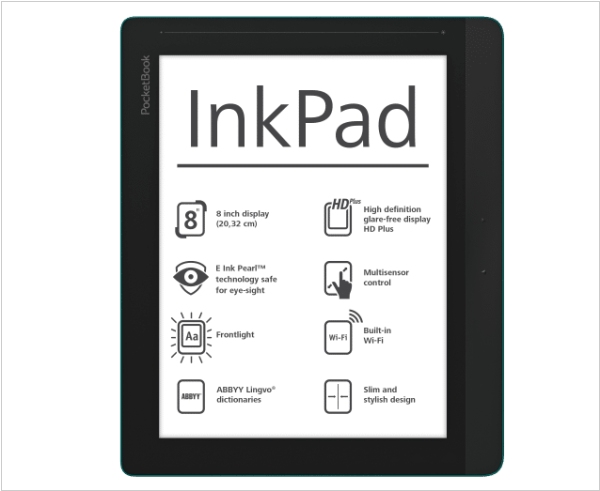
Pocketbook, a Ukrainian company with a consistent track record in manufacturing e-readers since 2007, has introduced a new device called InkPad that focuses on providing an expansive reading experience with its impressive eight-inch display. Utilizing E Ink Pearl technology, the device boasts the highest screen resolution available for such e-readers, with an impressive 1600×1200 pixel resolution. This high resolution enables users to adjust font sizes without compromising clarity. Equipped with a powerful 1GHz CPU and 512MB of RAM, the InkPad ensures smooth page-turning and stable performance across various applications. With 4GB of internal memory, expandable up to 32GB, users can amass a substantial library that is easily accessible at their fingertips. Additionally, the device includes a 3.5mm headphone jack for audiobook or music playback. Notably, Pocketbook has integrated Text to Speech functionality in this model, allowing users to have books read aloud to them.

